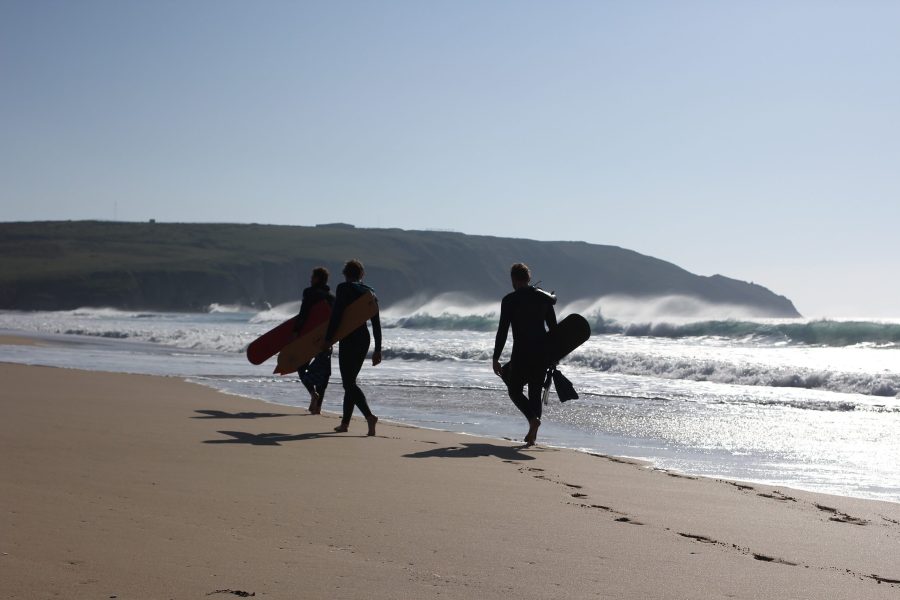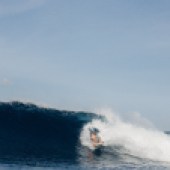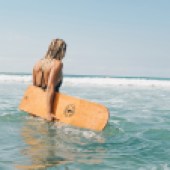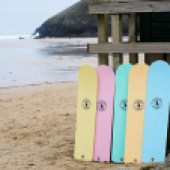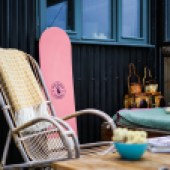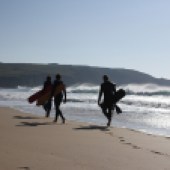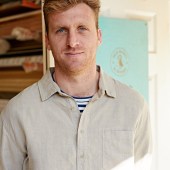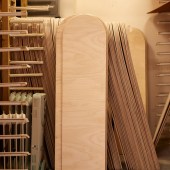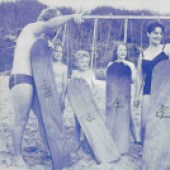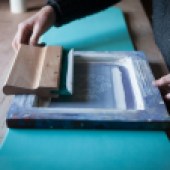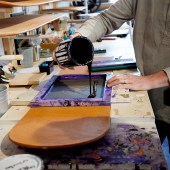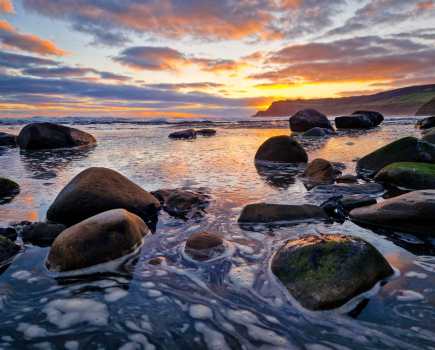Low tech, sustainable and easy to use, plywood bellyboards are making a comeback on Cornwall’s north coast as maker Dick Pearce & Friends stokes up a very British pursuit. WORDS JAMES STEWART
In 1937 Great Western Railway released a poster to promote its route to Newquay. It pictures two women in scarlet bathing suits riding a wave on wooden bellyboards, the proto-surfboards common on south-west beaches in the 1930s. Pure nostalgia, one might think, before meeting Jamie Johnstone whose workshop is above Newquay harbour, Cornwall’s surf capital. Amidst walls covered in chipboard and smells of paint and sawdust, Jamie lifts an unfinished bellyboard from a rack. It’s a 4ft plywood plank curving slightly to a round nose and is recognisably the same board as that on the GWR poster. ‘People think boards should have a high-performance aspect, but we’re still super low-fi. I love that about this business,’ he says.
The business in question is Dick Pearce Bellyboards, a family firm that began making bellyboards in a barn in South Molton, Devon, in the 1940s. As the surf scene evolved – from epoxy-foam longboards in the 1960s to imported modern shortboards and foam bodyboards in the 1980s – Dick continued to manufacture the simple boards surfed on British beaches since the turn of the century. After Dick’s death in 2010, his wife sold the business on spec to a surf shop customer, Andy Cameron of Wavehunters, and Jamie’s business partner. When Andy entered Dick’s barn he discovered original bellyboard templates and bandsaws, bending racks and screenprint stencils. ‘It was a treasure trove of British bellyboarding history,’ remarks Jamie.
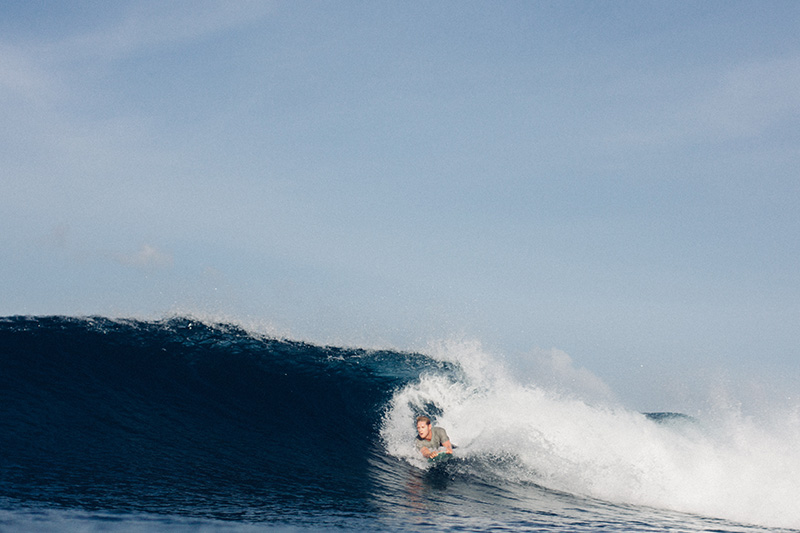
BRITISH PURSUIT
To fully understand that statement you need to know bellyboarding is distinctly British. Its boards refine those ridden by tourists in Hawaii in the early 1900s and pre-date anything in American or Australian surf-culture. The earliest photo of a British surfer, taken in 1919 (possibly earlier), shows one Hobart Braddick, owner of Braddick’s Holiday Centre in Devon, with a board that could have come from Jamie’s workshop. So bellyboarding is homegrown. It is 100% us.
The imperative to continue Dick Pearce Bellyboards was obvious. There was just one catch: after Dick’s death no one was certain how to make a board. The only guidance was a sheet of A4 found in the barn with 30 bullet-point instructions. The learning curve, Jamie says, was ‘massive’. ‘I literally had no idea what I was doing. We had to learn what rocker template [bend profile] to use, why some boards split, what paint to use, how to apply it, how to screenprint.’
Like Dick, Jamie now templates eight boards from each sheet of 9mm plywood, usually strong, slow-growing Russian or Latvian birch sourced from Dick’s original timber suppliers. He boils each for two hours before bending the softened shapes for a fortnight in Dick’s racks. Unlike Dick, Jamie sands the edges thoroughly; apparently, the original boards often gave you splinters. A bright coat of water-based paint or wood-stain, a screenprint of one of Dick’s cartoony logos – a puffin carrying a board, a dolphin or Neptune – and the boards are shop-ready.
BEACH COLOURS
Sold with a replica tag of Dick’s instructions on how to catch waves, they look beautiful. Painted in cheerful pastel colours – pink, bright orange, scarlet, aqua or lemon – they speak of carefree, sunny, beach days. Left plain, they’re lustrous, almost nutty in colour. A bargain, then, at prices from £45. Factor in that bellyboards are a doddle to ride and it’s little wonder sales have increased ten-fold since 2016 to around 2,000 a year.
Yet there’s more to this than nostalgia. These bellyboards capture something surprisingly modern. As surfing has gone from counter-culture to mainstream, some surfers have re-evaluated surfing’s roots. Instead of performance surfboards and radical moves, they have returned to the craftsmanship of shaping wooden boards and soul-surfing. By stripping surfing to its essentials and evoking a simpler era of wave-riding, bellyboards tap into the zeitgeist.
That they also let you ride sloppy, otherwise unsurfable waves makes the British coast – with its erratic, often wind-chopped swell – ideal territory. Jamie says: ‘On these boards I can get out in crap conditions I wouldn’t usually surf and it’s so enjoyable. You’re going really fast on this thin plank and feel really connected to the wave. You don’t get that in bodyboarding with a chunk of foam underneath you.’
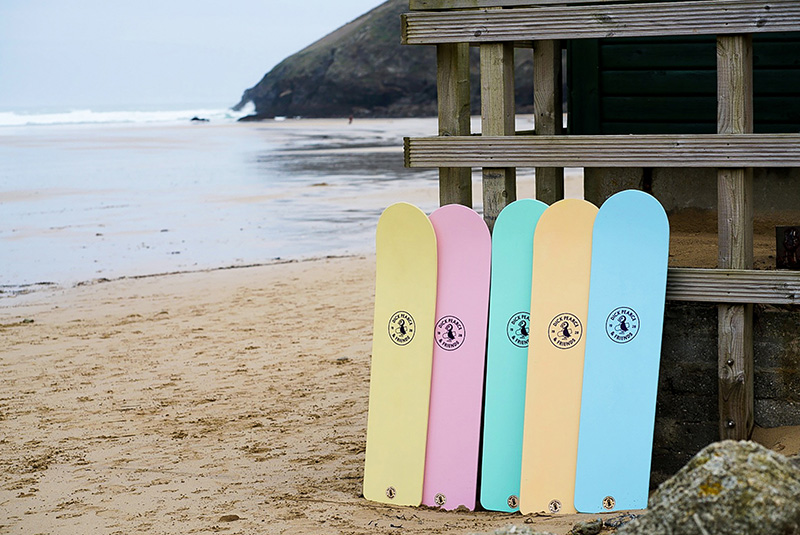
ECO CREDENTIALS
Ah, yes, bodyboarding. While kids’ foam bodyboards seem like cheap wholesome fun, they’re environmentally toxic – quick to snap and made of polyester foam, which cannot be recycled. They are not fit for purpose, says Jamie, who has a Masters in marine renewable energy and formerly worked in the solar power industry. ‘I really hate disposable culture. I live above Newquay’s Fistral Beach and see bins full of broken bodyboards – 10, 20 a day in summer, so 800 to 1,000 over six weeks. It all goes to landfill. The price of a board doesn’t reflect its long-term cost.’ He hopes wooden bellyboards, handmade and sustainable, will become treasured possessions.
Fine in theory. But what are they like to surf? To be honest, my expectations are not high when we pull on flippers in Newquay harbour. I surf – not brilliantly, admittedly – so am sceptical that a design that pre-dates the 1920s can compare to a modern surfboard. We kick out beyond the breakers, the bellyboards barely floating beneath us, duck-diving under chest-high aquamarine waves (a cinch compared to a surfboard, incidentally). I’ve only been in the line-up a few minutes before I’m sliding down my first wave, a long ride across a glassy blue- green wave that is, by definition, overhead. I lose count of my how many waves I catch that session. More than I would have with a surfboard, that’s for sure. What strikes me most is the experience. My two hours in the water fuse the best bits of wild swimming – its connection with the sea and sense of freedom – with surfing’s chandelier-swinging euphoria of riding moving walls of water.
We return to the workshop buzzing. Jamie tells me about surfers who ride his bellyboards in overhead waves. I expect they have as much of a blast as kids making their debut in knee-high whitewater.
And that’s the thing about bellyboarding. What at first appears self-consciously nostalgic – ‘a niche hobby’, as Jamie calls it – taps into something too often overlooked in surfing, the simple life-affirming joy of being in the sea. Surfing is too serious, Jamie agrees. ‘It should be about playing in the sea. Bellyboarding isn’t cool – it’s a bit of plywood in the sea that’s really good fun, however good you are. It’s surfing as it was. As it should be.’
Find out more about the bellyboards made by Dick Pearce & Friends at dickpearce.com or call 07377 940517.
To read similar stories, visit our Coastal Activities section our our website, or pick up a copy of Coast magazine.
Right things on the right
- Accommodation: Duis aute irure dolor in reprehenderit in voluptate velit esse cillum dolore eu fugiat nulla pariatur. Excepteur sint occaecat cupidatat non proident.
- Hiking Temporibus autem quibusdam et aut officiis debitis aut rerum necessitatibus saepe eveniet ut et voluptates repudiandae sint et molestiae non recusandae.
- LINK 1
- LINK 2

